Fact Check: Did the EU-Turkey Deal Bring Down the Number of Migrants and of Border Deaths?
Posted:
Time to read:
Guest post by Thomas Spijkerboer, Professor of MigrationLaw, Vrije Universiteit Amsterdam. Thomas is on Twitter @ThomasS_VU.
On March 18th, 2016, the EU and Turkey agreed that all irregular migrants arriving on the Greek islands were to be returned to Turkey. It is generally believed that this agreement has led to a dramatic decrease of the number of irregular migrants, and hence of the number of border deaths. Exemplifying this idea is this quote from the second progress report of the European Commission on the implementation of the EU-Turkey Agreement: 'The sharp decrease in the number of irregular migrants and asylum seekers crossing from Turkey to Greece is proof of the Statement's effectiveness – and in particular, that the business model of smugglers can be broken. The clear message to migrants is that getting on a boat in Turkey, and endangering lives in the process, is not worth the risk given that there is a legal and safe pathway through resettlement.'
Are these claims correct?
If there were a causal relation between the EU-Turkey Agreement and the number of migrants and of migrant deaths, one would expect a decrease of both numbers after the agreement entered into effect on 20 March 2015. As the agreement was announced some time earlier, one would also expect an increase of both numbers just before that date, because one would expect many people trying to get to Greece before the agreement entered into force (the just in time-effect).
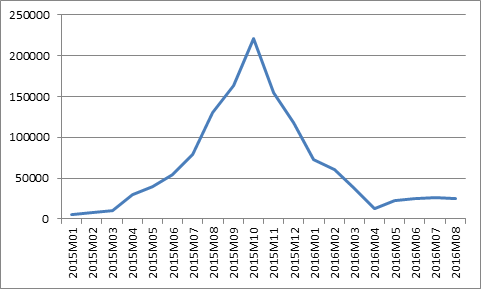
UNHCR data about the number of daily arrivals on the Greek islands in Figure 1, indicate a peak at 221,374 in October 2015. Following this spike, the number of arrivals goes down quite steadily. Analysis of the more detailed arrival data per week (Figure 2) does not indicate that the decreasing trend intensified after 20 March 2016. The trend is downward, and this overall trend is not affected by the agreement. The weekly data do show the expected increase just before the agreement was concluded (the peak at 24 February 2016 at 20,717 arrivals in one week). This would be an indication that the just in time-effect indeed occurred, i.e. people were aware that the agreement was coming, and decided to cross before they could be subjected to it. Alternatively, one may interpret this minor spike as just another irregularity in the steady downward trend since October 2015. In sum, the EU-Turkey Agreement has no identifiable influence on the overall declining number of crossings in the Aegean. Arguably, it led to a temporary increase in the weeks before it was concluded.
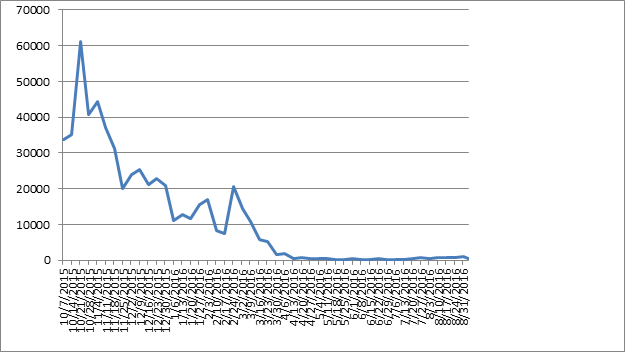
When we look at the number of border deaths for the same period, there are peaks in September-October 2015 and an even higher one in December 2015- January 2016. The number then drops sharply in February and March 2016 and there is a further decrease after March 2016.
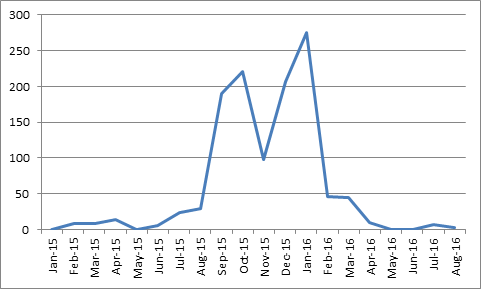
One might object that the EU-Turkey Agreement may not have led to the decline in the number of arrivals, but that it has probably contributed to preventing the expected increasing number of arrivals in the summer of 2016. It is certainly remarkable that the number of arrivals on the Greek islands remained so low throughout 2016. The data in Figure 2 begin in October 2015, and similar daily data are not available for the previous period. If we look at monthly data (Figure 1) however, we can observe that the number of arrivals in 2016 has returned to the situation as it was before the summer of 2015, when it was even lower than it is now. It seems more plausible to consider the peak in October 2015 as the exceptional situation in need of an explanation. If the EU-Turkey Agreement had any effect, it seems to have merely postponed the return to the usual low number of arrivals (through the just in time-effect).
Therefore, there is no identifiable relation between the EU-Turkey Agreement and the number of migrants crossing the Aegean from Turkey to Greece. The decline in numbers precedes the EU-Turkey Agreement, and the agreement has no identifiable relation to the decline (apart from possibly a temporary increase in the weeks before the agreement was concluded). Data on the number of border deaths show a minor positive development on the number of deaths after March 2016, but it is unlikely that this can be related to the EU-Turkey Agreement.
Did the closing of the Balkan land route lead to the decreasing number of asylum applications in the EU?
One might object that it was not so much, or not only, the EU-Turkey Agreement that led to the declining numbers, but the closing of the land borders on the Western Balkans. On November 18, 2015, Macedonia, Serbia, and Croatia began to restrict passage through their borders, allowing only asylum seekers from Syria, Iraq and Afghanistan to cross. This followed Slovenia’s decision the day before not to allow passage to asylum seekers and migrants from other countries, such as Iran, Eritrea, Somalia, Libya, Pakistan, Morocco, and Algeria. On January 21st, 2016, Macedonian authorities added an additional requirement, allowing Syrian, Iraqi, and Afghan asylum seekers through only if they intended to travel on to Germany or Austria. The Macedonian border was closed completely on March 9th, 2016, thus blocking the Balkan route. This means that closing down the Balkan land route took part gradually, between November 2015 and March 2016.
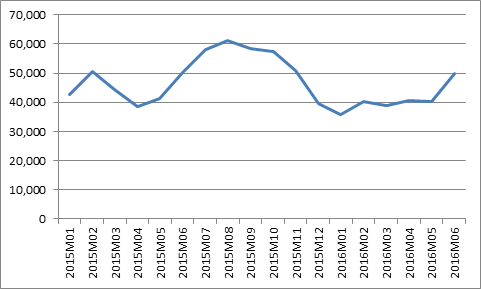
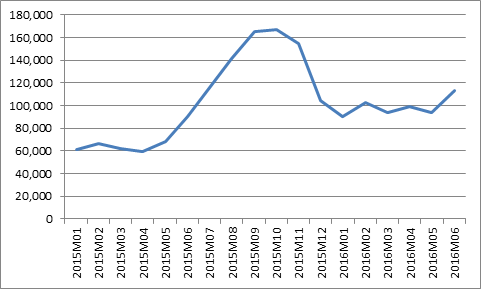
Taking these two figures together we can argue that the data on the effect of the beginning of the border closures in November 2015 are inconclusive; the data on the effect of the border closures on Afghans, Iraqis and Syrians contradict the idea that the border closures were related to the decline in the number of asylum applications. Therefore, all in all it is implausible that the closing of the Balkan land route is related to the declining number of asylum applications in Europe.
Are there better explanations for the decreasing number of arrivals and border deaths? (for an analysis of the initially increasing and then decreasing number of arrivals, you can read my blog post here).
The development of the number of border deaths is the subject of ongoing research by my colleague Tamara Last. One of her findings is that media-based datasets such as the IOM data used in this blogpost are very problematic. Partly this is because many bodies are never found and many people die without being reported to the authorities or the media. But for another part this is because media-based datasets reflect changes in media attention as much as changes in the number of deaths. Therefore, it is crucial to use a variety of sources. In addition to the media-based datasets that are popular in (non-)governmental organizations and the media, it is urgent to additionally use official data based on civil registries. Last has carried out such a research up until 2013, but our call to governments to collect these data from their own sources (i.e the digitalized civil registries they operate) for the period from 2014 up to the present have been ignored. Without a thorough analysis based on multiple data sources, it will be impossible to get a better explanation of the development of the number of border deaths.
What is the policy relevance of this?
The EU-Turkey Agreement is widely considered as an effective measure for migration control because it succeeded in bringing down the number of arrivals. Recently, chancellor Merkel has indicated she wants a refugee deal with Egypt and Tunisia too. The analysis of statistical data presented here shows that the decline in number of arrivals predates the EU-Turkey Agreement, and that if the agreement had any effect, that in fact is the interruption of this decline. If this analysis is correct, this means that governments should not trust that policies such as the EU-Turkey Agreement are effective in their aim to control migration.
In addition to this, the EU-Turkey Agreement came at considerable cost to the values which are fundamental to European society. One the one hand, it was concluded without asking the European Parliament for consent and without enabling the Court of Justice to give an opinion, thereby undermines constitutional values of the European Union. On the other hand, the agreement creates considerable tension with the prohibitions of refoulement and of collective expulsion. If a policy instrument such as the EU-Turkey Agreement has no identifiable use, but rather undermines fundamental values, arguably such policy instruments should not be implemented/used. Also, such a policy instrument results in rather complicated relations with the third country concerned (presently with Turkey, in the future potentially with Egypt and Tunisia). If refugee deals like the one between the EU and Turkey do not contribute to effectuating European policies, but do have such negative effects – shouldn’t the EU think twice before concluding them?
Any comments about this post? Get in touch with us! Send us an email, or post a comment here or on Facebook. You can also tweet us.
Share:








